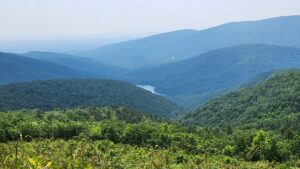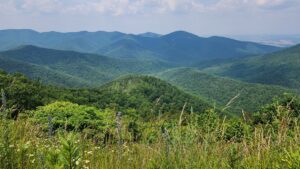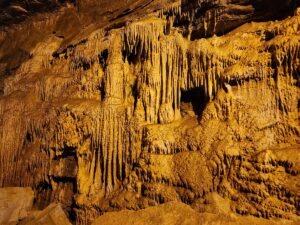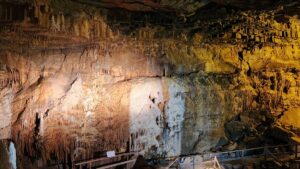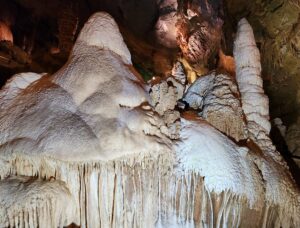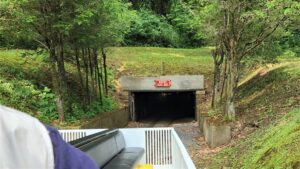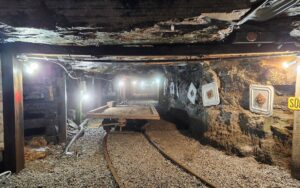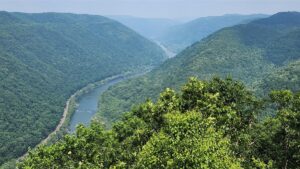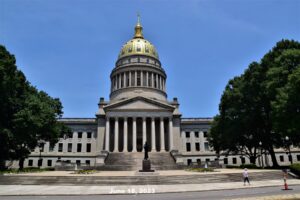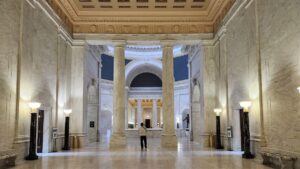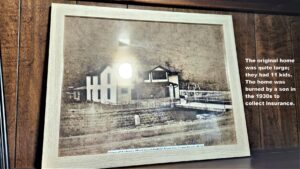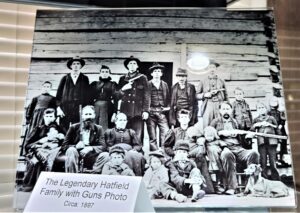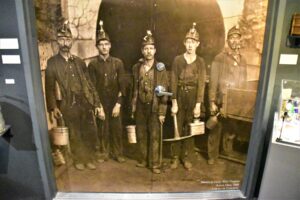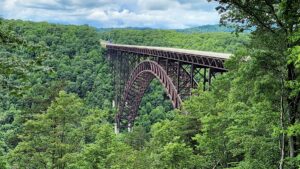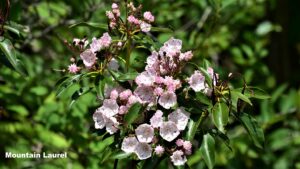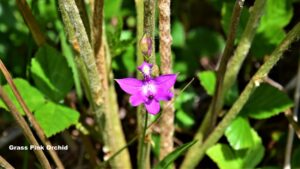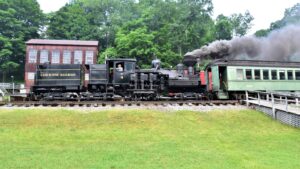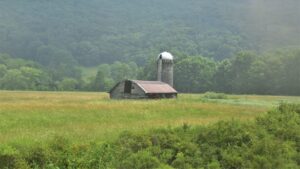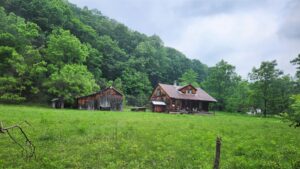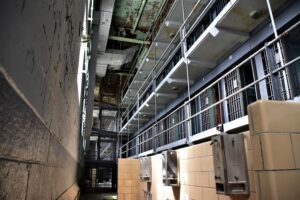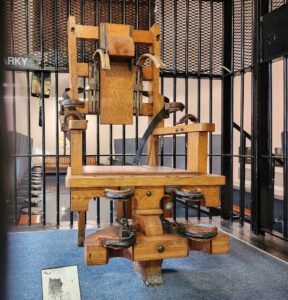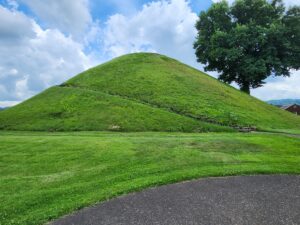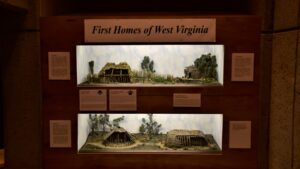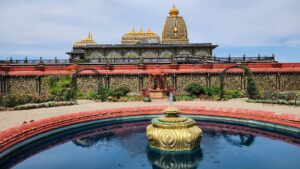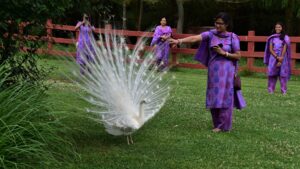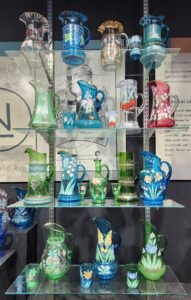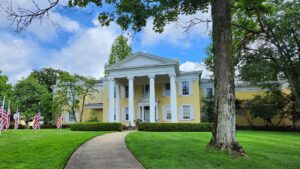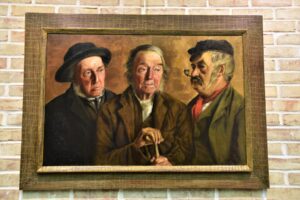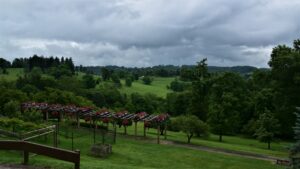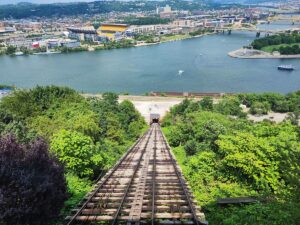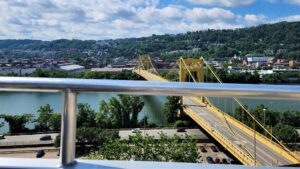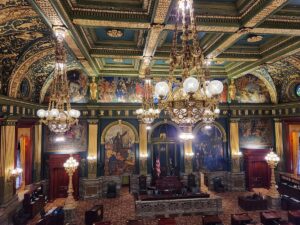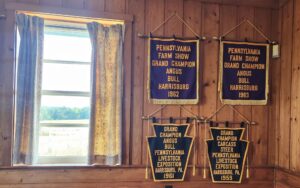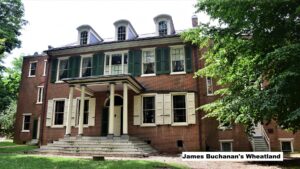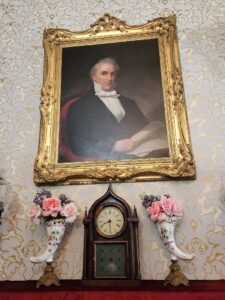JUNE
The first day of June found us at Harper’s Ferry, WV, a town known for a bloody fight in 1859, when John Brown, an abolitionist, staged an unsuccessful raid on a United States arsenal in an attempt to support a slave revolt. The town was later devastated by the Civil War and then several floods in the 1900s. The NPS has restored some buildings and maintains a shuttle service, museums and visitor centers. 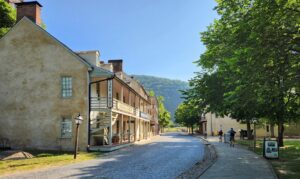
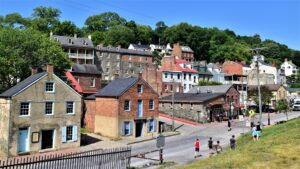 The town where the raid occurred is called the ‘lower town’ and it is built alongside a river, with the buildings layered up steep hillsides.
The town where the raid occurred is called the ‘lower town’ and it is built alongside a river, with the buildings layered up steep hillsides.
We were not quite finished with our sightseeing in Virginia, and our next stop was Shenandoah National Park, where we drove the famous Skyline Drive, at least for a short distance. The road was blocked by snow slides after a few miles, but we did get some great scenery and a pretty picnic spot, before we had to turn back. Forest fires in Canada pushed smoke into the area, obscuring the long-distance views.
Then we were back to exploring West Virginia, and all of its hills!
We have visited quite a few caverns, always fascinated by the various shapes that water dripping into a cave over centuries can create. In Lewisburg, we found Lost World Caverns, a privately owned, smallish cavern that has some great features along its .5 mile self-guided path.
The mining town of Beckley was next, where there is an underground exhibition coal mine. Our tour leader was a former mine worker, so we got the inside scoop on what a mining job was like, and we both decided we did not want to have that job!
(The tour leader said that he grew up “PO”, so poor that the family could not afford the “OR”.)
New River Gorge National Park, near Beaver, consists of New River and its watershed. We drove on both sides of the river for a few miles, passing through tiny towns and green hills and stopping at scenic overlooks to enjoy the views.
Our destination was Sandstone Falls, not a tall waterfall, but very wide and with a picnic area and trails to wander. 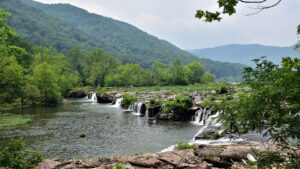
Charleston is the capital city of West Virginia, and the capitol building is stately and very pretty.
The West Virginia/Kentucky hills are known as the area where the Hatfield & McCoy feud took place in the mid-to-late 1800s. The Hatfield clan eventually moved to peaceful-sounding Sarah Ann to be further away from McCoys and law enforcement from Kentucky. They built a large house and many outbuildings and had a successful and prosperous life in the rugged hills, always with sentries posted, looking for intruders. The original house is gone now and a small museum stands in that space.
A huge Hatfield family cemetery is located on top of a nearby hill, accessed by a steep and rugged trail/almost road.
Matewan is a tiny town of 400 people, located on the border with Kentucky. 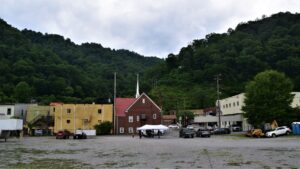
It was the site of a deadly 1920 struggle between miners, who wanted to join a union and went on strike, and mine owners (backed by government officials) who used rough tactics to prevent that from happening. On May 19, as security forces came to town to evict miners from company housing, a gun battle erupted that left 10 people dead. It became known as the Matewan Massacre. Bullets are still visible in some of the town’s buildings.
A very well done and informative museum in the town chronicles the mining history of the area. 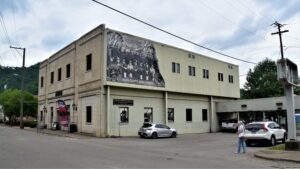
It is an interesting drive through the West Virginia back-country hills. There is a lot of poverty, shown in the run-down houses in tiny towns tucked beside a winding river and road, in steep walled canyons. Older homes are built right beside the road, while a lot of newer ones have a bridge across the river to access their property, if there is room between the edge of the hills and the road. Bruce was told by a guy we met that outsiders are not really welcome and to be aware of our surroundings at all times.
The north end of New River Gorge National Park is near Mount Lookout, where there is a famous bridge: The New River Gorge Bridge. The bridge is 3,030 feet long and 876 feet above New River, and it is the longest single span steel arch bridge in the U.S. There is a catwalk under the bridge where you can walk across the gorge and back ….no thanks!
Twisting, steep, curving, (did I mention twisty) roads brought us to Marlinton, and the Cranberry Glades, where there is a boardwalk through a bog that grows all kinds of fun plants, including wild cranberries. This is in the fun-to-say Monongahela National Forest. 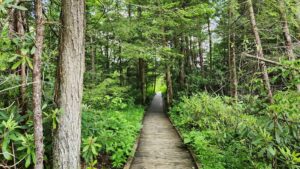
Cass is a tiny town in a valley that houses the Green Bank Observatory, a huge array of dishes that listen for sounds from the universe. The entire area is under an electronic blackout – no cell phones, wifi, television, etc.; there is a working landline at a nearby store to make calls. 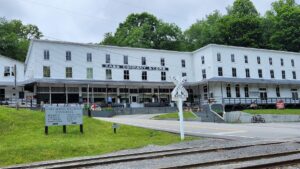
We took a coal-fired train ride from Cass to Durbin and back, a slow and peaceful ride through the countryside. The coal-fired train belches a lot of black, smelly smoke and you don’t want to be downwind of that!
At the nearby Green Bank Observatory, we found that the rules about electronic noise are even stricter. On the observatory grounds, the lawn mowers have electric motors because the spark plug needed to start a regular engine is electronic ‘noise’ to the radio telescopes. 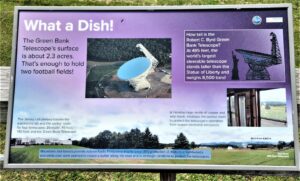 No microwaves can be used in the homes and the stores are wrapped in a protective insulation that does not allow wireless signals from the cash registers to escape the store walls. You cannot even take pictures with your cell phone as that can interfere with the very weak signals that they are trying to capture.
No microwaves can be used in the homes and the stores are wrapped in a protective insulation that does not allow wireless signals from the cash registers to escape the store walls. You cannot even take pictures with your cell phone as that can interfere with the very weak signals that they are trying to capture.
There is a good museum that explains all about the work they are doing at the observatory and the different types of signals that they are trying to receive. 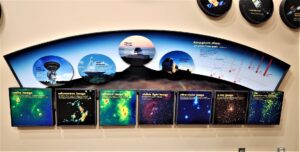 We took an electric tram tour of the telescope area, no digital cameras allowed, and then took a long distance shot of the big telescope, through the thick Canadian forest fire smoke.
We took an electric tram tour of the telescope area, no digital cameras allowed, and then took a long distance shot of the big telescope, through the thick Canadian forest fire smoke.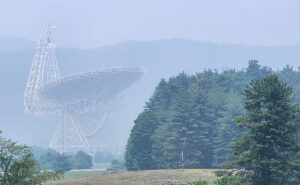
July
We started the month off with a visit to an insane asylum…. the Trans-Alleghany Lunatic Asylum, a huge complex built in the 1800s and used until 1994. 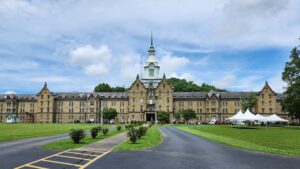 The building is rapidly deteriorating, but some areas have been restored enough to be open to the public. It was built at a time when it was felt that patients needed lots of light-filled rooms in order to recover, so the patient areas are quite pleasant.
The building is rapidly deteriorating, but some areas have been restored enough to be open to the public. It was built at a time when it was felt that patients needed lots of light-filled rooms in order to recover, so the patient areas are quite pleasant. 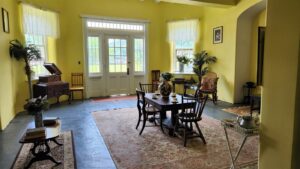
To round out our ‘institution tours’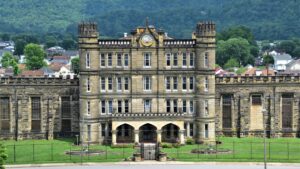 , we then took a tour of the West Virginia Penitentiary, a two block long Gothic style jail used from the 1800s until 1992.
, we then took a tour of the West Virginia Penitentiary, a two block long Gothic style jail used from the 1800s until 1992.
Across the street from the prison is a 2,000 year old, very large, burial mound and adjoining museum, Grave Creek Mound, in (the aptly named) Moundsville.
A very different type of compound, especially for West Virginia, was The Golden Palace, a retreat built for Srila Prabhupada, the man who brought Hare Krishna to the U.S. The place was built by volunteers beginning in 1973 and while it is still grand looking, 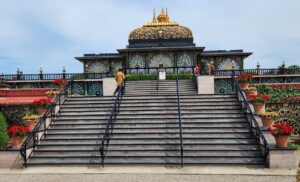 it needs a lot of work to maintain it. The grounds surrounding the buildings contain gardens, ponds and paths.
it needs a lot of work to maintain it. The grounds surrounding the buildings contain gardens, ponds and paths.
Our final stop in West Virginia was Oglebay Park in Wheeling. This was a huge private estate that was willed to the city to be used as a park and we really enjoyed our time there. We loved the glass museum 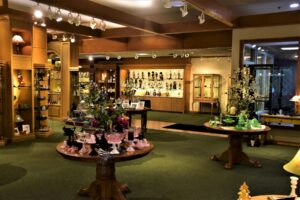
restaurant, shops…. really every part of it.
Pennsylvania was our next destination and Pittsburgh, the ‘Steel City’, was the first city we visited; a bustling place that was not our favorite to get around in, but we did some fun things. Pittsburgh’s claim to fame is that it has more bridges than any other U. S. city: 446!
The National Aviary was great and Gail got to participate in two bird ‘encounters’. The aviary hosts a group of penguins, and a unique way to view them is available. 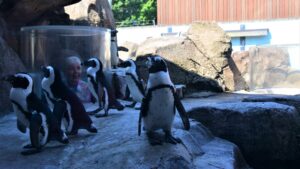 The opportunity to pet a penguin was too interesting to pass up, so Gail got to pet ‘Sidney’. The penguins get fish treats for participating, and they stand on a little rug and get a fish while they are getting petted. They are actually quite soft.
The opportunity to pet a penguin was too interesting to pass up, so Gail got to pet ‘Sidney’. The penguins get fish treats for participating, and they stand on a little rug and get a fish while they are getting petted. They are actually quite soft. 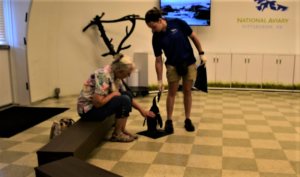
 Lorikeet Feeding is quite fun: You are given a small cup of very sweet nectar, which the Lorikeets love, and then you stand in their aviary while they sit on your hands and quickly slurp up every drop.
Lorikeet Feeding is quite fun: You are given a small cup of very sweet nectar, which the Lorikeets love, and then you stand in their aviary while they sit on your hands and quickly slurp up every drop.
We did some other sightseeing in Pittsburgh: a boat ride, an incline railroad ride and a Hop On/Hop Off bus. We tend to gravitate towards these 3 things in a new area because it gives such a great overview of what is available for us to visit. 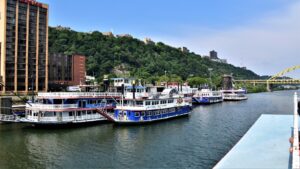
A branch of Gail’s ancestors lived in various parts of Pennsylvania, and we were lucky enough to find a Historical Library in Bellefonte that had cemetery records for several generations of the family. We spent a couple of days driving to area cemeteries to find and clean up their grave sites. All but one of the cemeteries were small community plots, surrounded by farm land. 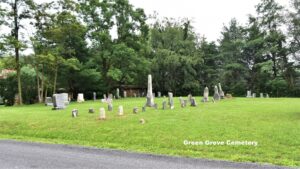
Harrisburg is the capital of Pennsylvania, and, of course, we had to check it out. The capitol is a lovely building, inside and out. 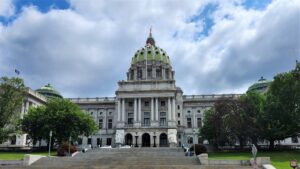
We also visited the historical museum, which has three floors of interesting displays. 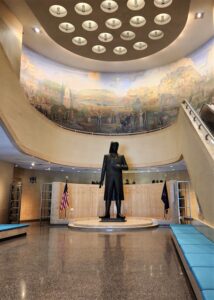
President and Mrs. Eisenhower purchased a farm, next to Gettysburg Battlefield, that is now a National Historic Site. 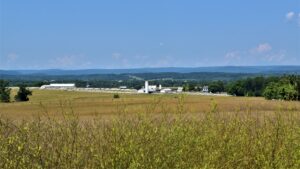 It is a scenic area and we spent a few hours touring the home and outbuildings. It was a working farm, with a prized cattle herd.
It is a scenic area and we spent a few hours touring the home and outbuildings. It was a working farm, with a prized cattle herd.
The next day, we spent the entire day at Gettysburg, took a bus tour of the large battlefield 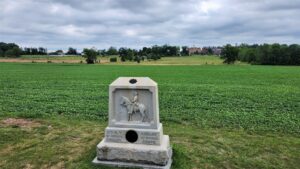 stopped at the Visitor Center and then visited the excellent museum.
stopped at the Visitor Center and then visited the excellent museum. 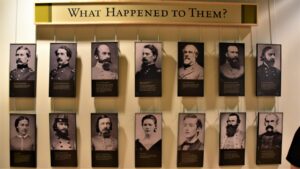 A highlight for us was the cyclorama,
A highlight for us was the cyclorama, 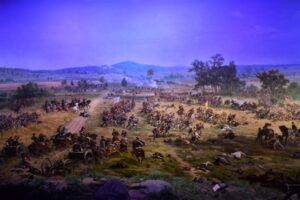 a round, room-sized oil painting depicting scenes from the battle.
a round, room-sized oil painting depicting scenes from the battle.
We could have spent more than one day at Gettysburg, because there is so much to see and learn.
We needed a sweet break from all the horrors of war, and Hershey fit that perfectly. 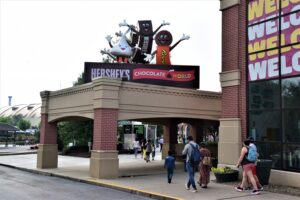
We took a bus tour of the town to learn about the start of Hershey and how much it supports the town now. The Hershey’s were not able to have children of their own, so they started a live-in orphanage/school for area children in need. The sales of Hershey candies support this town and school to this day. 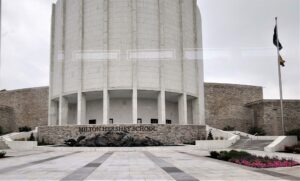
The Hershey ‘museum’ has lots of interactive chocolate adventures, plus an amazing amount of chocolate goodies for sale. 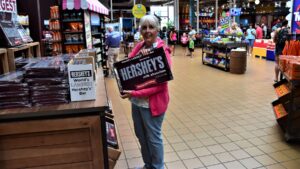 We went home well stocked!
We went home well stocked!
Train enthusiasts should know about the Train Museum of Pennsylvania in Strasburg, with a huge display of well restored trains. 
President James Buchanan purchased ‘Wheatland’ before he became president and then retired to the place, and passed away in it in 1872. The home has remained essentially unchanged since his time there.
We had a very busy couple of months! August, 2023 is next.

